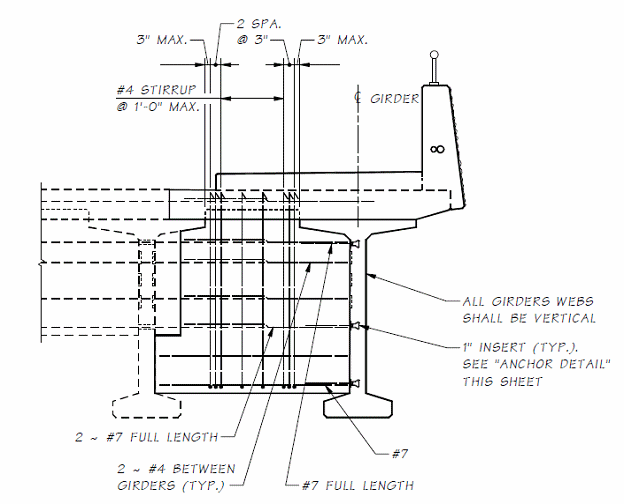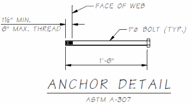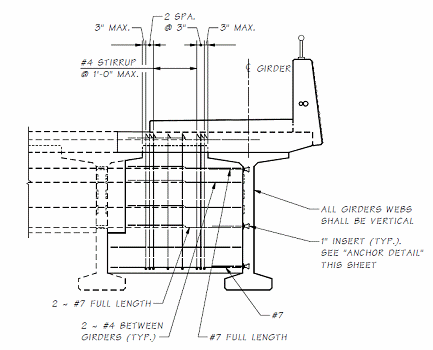
Strand couplers for 0.6” diameter strands are not commercially available. Strand couplers may be used to transition from 0.6” to 0.5” diameter strand to accommodate the use of 0.5” diameter strand splice to re-tension damaged or broken strands. Prestressed girder bridges with full depth intermediate diaphragms provide better resistance to over-height load impacts than partial depth diaphragms. Damaged girder replacement often requires replacement of the intermediate diaphragms. This provides the designer an opportunity to specify full depth intermediate diaphragms for replacement. Replacement for damaged girders should preferably be of the same type as the original girders. Damaged girder replacement often involves outside parties for cost recovery. Replacement in-kind is preferable for cost negotiations.
Note: Click here for a PDF of this design memo.
Figure 1. Full Depth Intermediate Diaphragms Replacement
5.6.6 Repair of Damaged Girders in Existing Bridges
A.
General - This section is intended
to cover repair of damaged girders on existing bridges. For repair of newly
constructed girders, see Section 5.6.5. Overheight
loads are a fairly common source of damage to prestressed
girder bridges. The damage may range from spalling
and minor cracking of the lower flange of the girder to loss of a major portion
of a girder section. Occasionally, one or more strands may be broken. The
damage is most often inflicted on the exterior or first interior girder. B. Repair Procedure - The determination of the degree of damage
to a prestressed girder is largely a matter of
judgment. Where the flange area has been reduced or strands lost, calculations
can aid in making this judgment decision. The following are general categories
of damage and suggested repair procedures15,16.
1.
Minor Damage - If the damage is slight and
concerns only spalling of small areas of the outside
surface of the concrete, repair may be accomplished by replacing damaged
concrete areas with concrete grout. The
area where new concrete is to be applied shall first be thoroughly cleaned of
loose material, dried, and then coated with epoxy.
2.
Moderate Damage - If damage is moderate,
consisting of loss of a substantial portion of the flange and possibly loss of
one or more strands, a repair procedure must be developed using the following
guidelines. It is probable that some prestress will have been lost in the damaged area due to
reduction in section and consequent strand shortening or through loss of
strands. The following repair procedure is recommended to assure that as much
of the original girder strength as possible is retained: a. Determine Condition - Sketch the remaining cross section of the
girder and compute its reduced section properties. Determine the stress in the damaged girder
due to the remaining prestress and loads in the
damaged state. If severe overstresses are found, action must be taken to
restrict loads on the structure until the repair has been completed. If the
strand loss is so great that AASHTO prestress
requirements cannot be met with the remaining strands, consideration should be
given to replacing the girder. b. b. Restore Prestress If Needed
- If
it is determined that prestress must be restored,
determine the stress in the bottom fiber of the girder as originally designed
due to DL + LL + I + Prestress.
(This will normally be about zero psi). Determine the additional load (P) that, when applied to the
damaged girder in its existing condition, will result in this same stress. Take
into account the reduced girder section, the effective composite section, and
any reduced prestress due to strand loss. Should the damage occur outside of the middle
one-third of the span length, the shear stress with the load (P) applied should also be computed.
Where strands are broken, consideration should be given to coupling and jacking
them to restore their prestress. c. c. Prepare a Repair Plan - Draw a sketch to show how
the above load is to be applied and specify that the damaged area is to be
thoroughly prepared, coated with epoxy, and repaired with grout equal in
strength to the original concrete. Specify that this load is to remain in place
until the grout has obtained sufficient strength. The effect of this load is to
restore lost prestress to the strands which have been
exposed. d. d. Test Load - Consideration should be given to testing the
repaired girder with a load equivalent to 1.0DL + 1.5(LL+IM). The LL Live Load for test load is HL-93.
3.
Severe Damage - Where the damage to the
girder is considered to be irreparable due to loss of many strands, extreme
cracking, etc., the girder may need to be replaced. This has been done several
times, but involves some care in determining a proper repair sequence. In general, the procedure consists of cutting
through the existing deck slab and diaphragms and removing the damaged girder.
Adequate exposed reinforcement steel must remain to allow splicing of the new
bars. The new girder and new reinforcement is placed and previously cut
concrete surfaces are cleaned and coated with epoxy. New deck slab and
diaphragm portions are then poured. It
is important that the camber of the new girder be matched with that in the old
girders. Excessive camber in the new
girder can result in inadequate deck slab thickness. Girder camber can be
controlled by prestress, curing time, or dimensional
changes. Pouring
the new deck slab and diaphragms simultaneously in order to avoid overloading
the existing girders in the structure should be considered. Extra bracing of
the girder at the time of deck slab pour shall be required. Methods
of construction shall be specified in the plans that will minimize inconvenience
and dangers to the public while achieving a satisfactory structural result.
High early strength grouts and concretes should be considered. In case of replacement of a damaged girder, the intermediate diaphragms
adjacent to the damaged girder shall be replaced with full depth diaphragms as
shown in Figure 1. In case of replacement of a damaged girder, the replacement girder
shall preferably be the same type as the original damaged girder. In case of repair of a damaged girder with broken or damaged prestressing strands, the original damaged diameter strands
shall be replaced with similar diameter strands. Currently, 0.6” diameter
strand couplers are not commercially available. If 0.6” diameter strands must
be replaced, 0.5” diameter strands may be used instead. Restoration of the prestress
force as outlined in BDM 5.6.6 B-2b shall be considered. Existing
bridges with pigmented sealer shall have replacement girders sealed. Those
existing bridges without pigmented sealer need not be sealed.
4.
Repair vs. Replacement of
Damaged Girder - Several
factors need to be considered when evaluating whether to repair or to replace a
damaged girder. Among them are the level of concrete damage, number of broken
strands, location and magnitude of web damage, permanent offset of the original
girder alignment, and overall structural integrity. Other considerations
include fresh damage to previously damaged girders, damage to adjacent girders,
and cost of repair versus replacement. Ultimately, the evaluation hinges on
whether the girder can be restored to its original capacity and whether the
girder can be repaired sufficiently to carry its share of the original load. The following guidelines describe damaged
girder conditions which require replacement: •
Strand Damage: More than 25% of prestressing strands are damaged/severed.
If over 25% of the strands have been severed, replacement is required. Splicing
is routinely done to repair severed strands. However, there are practical
limits as to the number of couplers that can be installed in the damaged area. •
Girder Displacements: The bottom flange is
displaced horizontally position more than ½″ per 10′ of girder length. If the alignment of the
girder has been permanently altered by the impact, replacement is required.
Examples of non-repairable girder displacement include cracks at the web/flange
interface that remain open. Abrupt lateral offsets may indicate that stirrups
have yielded. A girder that is permanently offset may not be restorable to its
original geometric tolerance by practical and cost-effective means. •
Concrete Damage at Harping
Point: Concrete
damage at harping point resulting in permanent loss of prestress.
Extreme cracking or major loss of concrete near the harping point may indicate
a change in strand geometry and loss in prestress
force. Such loss of prestress force in the existing
damaged girder cannot be restored by practical and cost effective means, and
requires girder replacement. •
Concrete Damage at Girder
Ends: Severe
concrete damage at girder ends resulting in permanent loss of prestress or loss of shear capacity. Extreme cracking or
major loss of concrete near the end of a girder may indicate unbonding of strands and loss in prestress
force or a loss of shear capacity. Such loss of prestress
force or shear capacity in the existing damaged girder cannot be restored by
practical and cost-effective means, and requires girder replacement. There
are other situations as listed below which do not automatically trigger
replacement, but require further consideration and analysis. •
Significant Concrete Loss: for girder
damage involving significant loss of concrete from the bottom flange,
consideration should be given to verifying the level of stress remaining in the
exposed prestressing strands. Residual strand stress values will be
required for any subsequent repair procedures. •
Adjacent Girders: Capacity of adjacent
undamaged girders. Consideration must be given as to whether dead load from the
damaged girder has been shed to the adjacent girders and whether the adjacent
girders can accommodate the additional load. •
Previously Damaged Girders: Damage to a previously
damaged girder. An impact to a girder that has been previously repaired may not
be able to be restored to sufficient capacity. Cost: Cost of repair versus replacement. Replacement may be warranted if the cost of repair reaches 70% of the replacement project cost. A. Miscellaneous References – The following girder replacement contracts and similar jobs should be used for guidance:
|
|||||||||||||||||||||||||||||||||||||||||||||||||||||||||||||||||||||||||||||||||||||||||||||||||||||||||||||||||||||||


